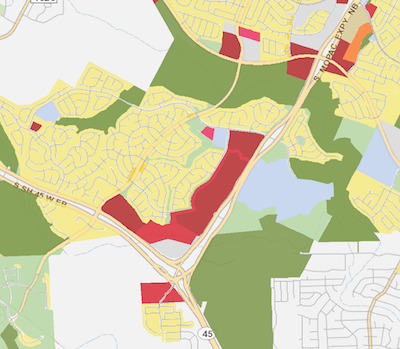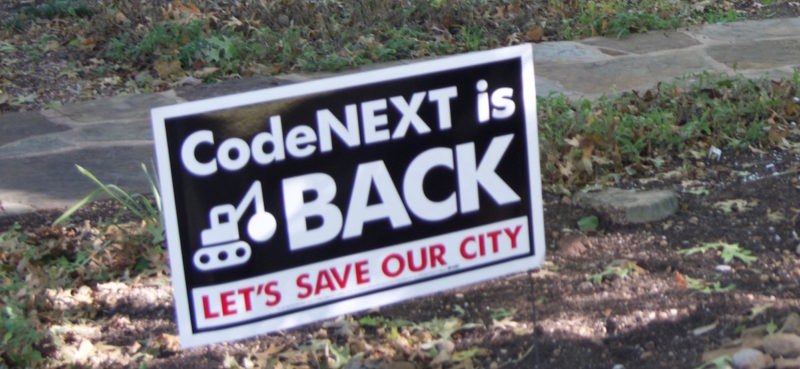Heard of “CodeNEXT” or “LDC,” the Land Development Code? Have a general idea what this is all about but not really sure of the specifics?
Well, you’re in luck as we’ve put together a handy guide with concrete examples. In general, the revised land code (which is currently under consideration by the City Council) would increase density in large parts of the city and could trigger a building boom.
But that’s not the case everywhere. Let’s take a look:
Higher Density Off Airport Blvd
Between I-35 and Airport Boulevard, single-family residential blocks will be upzoned for “neighborhood scale mix use,” allowing three- to four-story buildings. Other blocks will be rezoned to allow up to four residential units on a property. Many properties that immediately adjoin Airport Boulevard or I-35 will also be upzoned to permit mid-rise commercial or residential development.
Farther to the north, Austin Community College’s Highland Campus just north of 290 would be upzoned to allow mid-rise buildings up to 85 feet tall.
‘Main Street’ Zoning on East MLK

A fast-gentrifying strip of East Martin Luther King Boulevard that is now zoned for limited offices and general commercial services would be rezoned as a “main street zone.” This would require properties along MLK to have pedestrian-friendly ground-floor uses, while the upper levels could be used for a variety of purposes. The idea is to make the area walkable and easily serviceable by transit, with a mix of residential and commercial functions in the same general vicinity.
Commercial Center at W. Slaughter Lane and Manchaca Road
This is a busy commercial junction that sits in the midst of several single-family neighborhoods, including Castlewood Forest and The Hollow at Slaughter Creek. Under the new code, the strip-mall style shops and restaurants in the area could give way to some mid-rise mixed-use buildings.
Some of the immediately adjoining residential blocks could become somewhat denser with up to six residential units on properties that are currently single-family, particularly along the main roads.
From Single-Family to Two-Family Lots
Many neighborhoods where developers currently are allowed to build only single-family homes would be rezoned to R2A, a designation that allows up to two units on a property, such as a duplex or an accessory dwelling unit. Large setbacks would still be required in these neighborhoods, and bigger apartments would not be allowed.
Examples include Rosedale off Lamar Blvd, the Balcones Oaks and Oak Forest neighborhoods off Jollyville Road in North Austin, Mesa Oaks off Far West Boulevard, and many parts of East Austin including Holly and the residential areas south of East Cesar Chavez.
Hyde Park and Travis Heights Unchanged

Certain neighborhoods will keep their zoning with minimal or no changes, including Travis Heights and Hyde Park. In Hyde Park, some blocks would be upzoned slightly to RM1-HD or R4-HD, “missing middle” designations that allow up to four units on a property in an historic district.
Apartments in Northeast Austin
Although parts of East Austin will preserve a single-family neighborhood character, certain corridors might see increased density. For example, a strip of undeveloped land along Dessau Road currently zoned for single family would be rezoned for low- to mid-rise residential, while certain existing single-family lots along Dessau could be redeveloped into “missing middle” housing that allows up to four units per property.
At the junction of Dessau and Rundberg, strip mall-style shops would be rezoned for mid-rise mixed-use, with a height bonus for developers that include affordable residential units. The core of the single-family Windsor Hills neighborhood would remain untouched, except that residents would be allowed to add a second unit to their property in the form of a duplex or ‘granny flat,’ as with the other neighborhoods mentioned above.
W. Parmer Lane and Mopac

The Parmer/Mopac junction is a busy commercial area with a high volume of vehicle traffic. It currently features strip-mall style shops, drive-through banks, and fast food restaurants. The area would be rezoned to allow for taller buildings, with most of the new density east of Mopac, encroaching slightly into the Tomanet Estates and North Star neighborhoods. For example, some blocks along Parmer currently zoned “neighborhood commercial” would get a somewhat denser commercial designation. Transitional residential blocks that back onto Parmer Lane could be developed to allow up to four to six units per property.
More Offices or Apartments Along South Mopac

Undeveloped land at the south end of Mopac where it meets SH-45 could give way to office space or mixed-use buildings. This strip of highway-facing land is currently zoned for general commercial services with a maximum height of 60 feet, but under the new code’s incentive bonus program it could be built as tall as 90 feet if the developer includes affordable housing. A transitional strip of green space would buffer homes in the Circle C Ranch neighborhood.
Mid-Rise Buildings at Four Points (2222 and 620)
At the junction of FM 2222 and FM 620, an area dense with big-box stores like Target, H-E-B, and Walgreens, some properties would be upzoned from a general community commercial designation under the current code to a mid-rise zone. However, a developer would need to participate in an affordability bonus program in order to build taller.
More Homes Around the Triangle
North of the Triangle, an area that has boomed with mixed-use development, the remaining single-family neighborhoods like North Loop could be transformed along some corridors as single-family plots are rezoned for four-unit to six-unit residences. This includes blocks of North Loop Boulevard and Genard Street. Pockets of single-family homes would remain between the Triangle and the Airport Boulevard corridor to the east.
